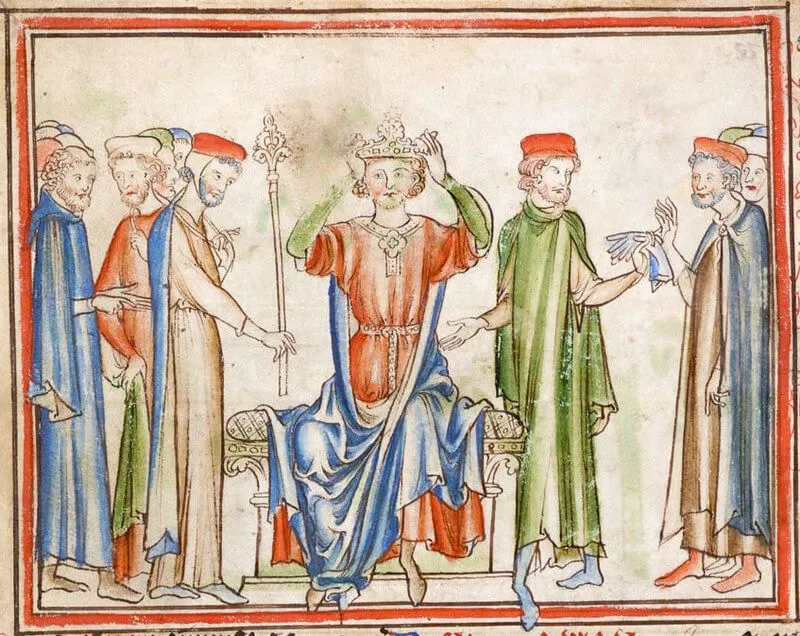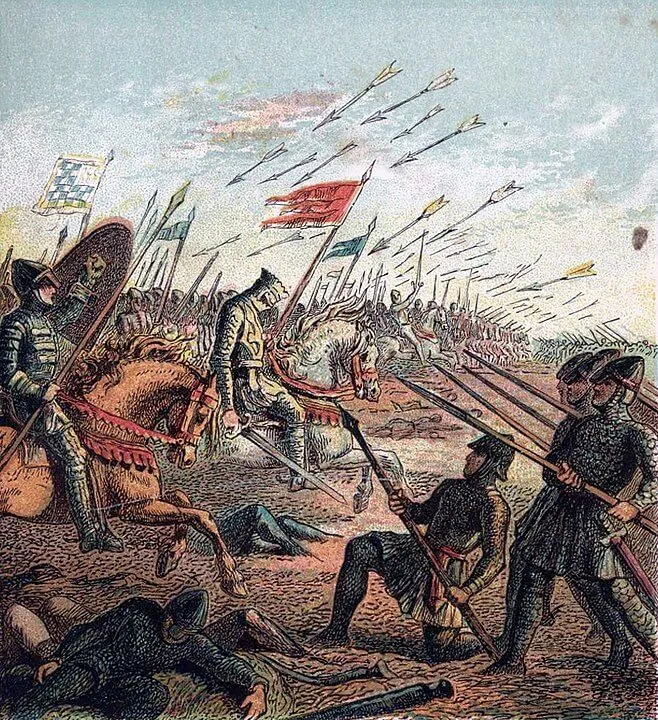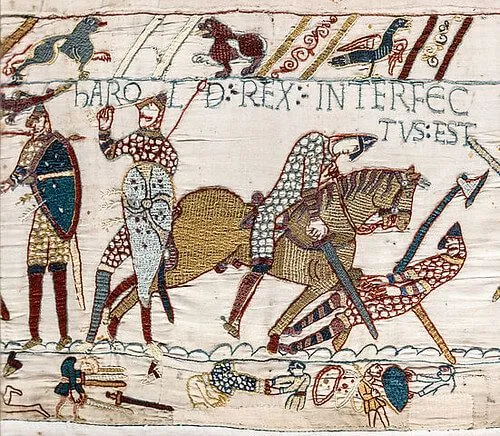FOR AGES 7 YEARS TO 11 YEARS
What have you heard about the legendary Battle of Hastings?
Do you know your Anglo Saxon from your Norman? Have you learnt all about the legendary Bayeux Tapestry? You might already know what some of these things are from history lessons in school, but if you're not too sure and your kids are learning about this topic, don't worry!
We'll be covering all the key points about the Battle of Hastings, what happened during the battle and who was victorious in the end. Read on to discover all you need to know...
The Battle of Hastings is one of the most well-known battles that happened in the Middle Ages (or the Medieval Period) in England on 14th October 1066. William, the Duke of Normandy and leader of the Norman army from France, fought against the newly crowned king, Harold II, along with his fellow English Anglo Saxon army to decide who would become the King of England.

Harold Godwinson - King Harold II
Harold Godwinson was the Earl of Wessex, a rich nobleman who had not only advised Edward the Confessor, the before he died, but was also his brother-in-law. He had lots of support from other English noblemen and even succeeded Edward as king of England - but would he remain King for long?
William, Duke of Normandy
William, Duke of Normandy, was a distant cousin of Edward the Confessor and claimed that he had a right to the English throne as promised by Edward. He also argued that Harold II betrayed him as he said that he would support William in his fight for the crown.
William gained a lot of support for his claim and even had backing from the Pope. This meant that the powerful Catholic Church recognised him as the rightful ruler, which symbolised his 'divine' right to rule England. So what would this mean in the upcoming battle?
Edward the Confessor was one of the last English kings of Anglo Saxon heritage. He sat on the throne from 1042 until his death in 1066. He had no children to inherit the throne which meant England had no new ruler so it was left vulnerable to attack.

Following Edward's death, Harold II was crowned king of England by the King's Council on 6th January 1066 to stop any attacks. However, there were several other people who also claimed that they had the right to be king of England.
Edgar Atheling was the great-nephew of Edward the Confessor and though he could try and win the throne, he was weak and had no support so he was unable to.
Harald Hardrada was a famous Viking, and the king of Norway who tried winning against Harold II. Harald Hardrada came over by ship to England in September 1066 with his Viking army and battled against the Anglo Saxons twice in Yorkshire with the help of Harold II's own half-brother Tostig. Though they won the first fight, both Tostig and Hardrada died in the second at the Battle of Stamford Bridge.
But there was another who felt he had the right to rule - can you guess who? William, Duke of Normandy of course!
William was a well known military leader, and after hearing of Harold II becoming king, decided to fight for his claim to the throne. As we know, he gained a lot of support from his fellow Normans and even the Pope.
In September 1066, William's large army sailed on 700 ships from France to Sussex, England where they attacked and built up their defence.
Harold II had just finished defeating Harald Hardrada in York when he heard that England had been invaded. He then travelled all the way down from the north of England with some of his Anglo Saxon army of foot soldiers. Not only were his soldiers tired from the previous fight, but they also marched for around two weeks to reach William's army!

The Battle of Hastings began at Senlac Hill in Sussex on 14th October 1066.
In the morning, Harold's army positioned themselves at the top of the hill, forming a shield wall. William's army fought from below, with archers and men on horses who tried to charge uphill but found it hard.
The battle continued on all day with both armies fighting. It has been suggested that there was a rumour that William had died but declared that he was still alive, which gave his army a boost in confidence.
Later on in the day, William got his army to pretend to run away so that they could try and get the English army to break their wall by tricking them which worked! With his skilled army, William was able to eventually defeat Harold II who was killed, though we are not sure how he died.
After the battle, William marched to London to claim his victory and took over as King.
Did You Know? There is a legend that says Harold was killed by an arrow shot through his eye?
After the battle and what became known as the Norman Conquest, William became the first Norman King of England on Christmas Day in 1066 and transformed Anglo Saxon England.
Known as William the Conqueror, he officially ended around 600 years of Anglo Saxon rule through winning the Battle of Hastings.
As King, William made changes to Anglo Saxon English by mixing it with French, resulting in what would become today's spoken English. He built links to Europe, created the census known as the 'Domesday Book' and influenced the creation of the Bayeux Tapestry (as seen below), which tells the story about the battle and his triumph and is approx 70m long!

To get your kids thinking more about the topic, they could:
-Draw the 'key players' and write a story about them!
-Research what types of weapons and armour the Anglo Saxons and Normans used and design their own.
-Design their very own Bayeux Tapestry.
That's it! The Battle of Hastings explained for your little historians. We hope we've helped you learn more about English history and hope that you continue to have fun on your historical adventures.
Read The Disclaimer
At Kidadl we pride ourselves on offering families original ideas to make the most of time spent together at home or out and about, wherever you are in the world. We strive to recommend the very best things that are suggested by our community and are things we would do ourselves - our aim is to be the trusted friend to parents.
We try our very best, but cannot guarantee perfection. We will always aim to give you accurate information at the date of publication - however, information does change, so it’s important you do your own research, double-check and make the decision that is right for your family.
Kidadl provides inspiration to entertain and educate your children. We recognise that not all activities and ideas are appropriate and suitable for all children and families or in all circumstances. Our recommended activities are based on age but these are a guide. We recommend that these ideas are used as inspiration, that ideas are undertaken with appropriate adult supervision, and that each adult uses their own discretion and knowledge of their children to consider the safety and suitability.
Kidadl cannot accept liability for the execution of these ideas, and parental supervision is advised at all times, as safety is paramount. Anyone using the information provided by Kidadl does so at their own risk and we can not accept liability if things go wrong.
Kidadl is independent and to make our service free to you the reader we are supported by advertising.
We hope you love our recommendations for products and services! What we suggest is selected independently by the Kidadl team. If you purchase using the buy now button we may earn a small commission. This does not influence our choices. Please note: prices are correct and items are available at the time the article was published.
Kidadl has a number of affiliate partners that we work with including Amazon. Please note that Kidadl is a participant in the Amazon Services LLC Associates Program, an affiliate advertising program designed to provide a means for sites to earn advertising fees by advertising and linking to amazon.
We also link to other websites, but are not responsible for their content.
Was this article helpful?



Browse Category



We’ll send you tons of inspiration to help you find a hidden gem in your local area or plan a big day out.



Check your inbox for your latest news from us. You have subscribed to:
Remember that you can always manage your preferences or unsubscribe through the link at the foot of each newsletter.